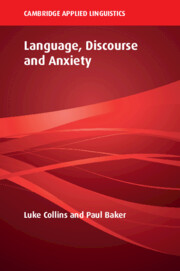Book contents
- Language, Discourse and Anxiety
- THE CAMBRIDGE APPLIED LINGUISTICS SERIES
- Language, Discourse and Anxiety
- Copyright page
- Contents
- Figures
- Tables
- Acknowledgements
- Preface
- 1 Anxiety, Online Fora and This Study
- 2 Sketching Anxiety
- 3 The Lived Experience
- 4 Creating a Community
- 5 Sex and Gender
- 6 Comparing Cultures
- 7 Time
- 8 Conclusion
- References
- Index
4 - Creating a Community
Published online by Cambridge University Press: 08 June 2023
- Language, Discourse and Anxiety
- THE CAMBRIDGE APPLIED LINGUISTICS SERIES
- Language, Discourse and Anxiety
- Copyright page
- Contents
- Figures
- Tables
- Acknowledgements
- Preface
- 1 Anxiety, Online Fora and This Study
- 2 Sketching Anxiety
- 3 The Lived Experience
- 4 Creating a Community
- 5 Sex and Gender
- 6 Comparing Cultures
- 7 Time
- 8 Conclusion
- References
- Index
Summary
Here, we consider the interactive and online affordances of the forum by looking at the ways that posters respond to each other’s posts. What kind of language use characterises those which receive numerous responses vs those which receive none at all? We also ask, how do posters reach consensus and, considering the range of posts of people from different backgrounds, how is disagreement around understandings of anxiety negotiated? We code a sample of the forum posts using Egbert et al.’s (2021) coding scheme for functional discourse units. This is based on nine codes which indicate the particular purpose of a stretch of interactive text; for example, joking around, engaging in conflict or giving advice. Additionally, we look at uses of computer-mediated communication, including acronyms such as lol and emojis which are often used for affiliative purposes and disambiguation. This chapter uses corpus-based frequency approaches to identify longer stretches of interaction which are then examined qualitatively.
- Type
- Chapter
- Information
- Language, Discourse and Anxiety , pp. 96 - 134Publisher: Cambridge University PressPrint publication year: 2023

